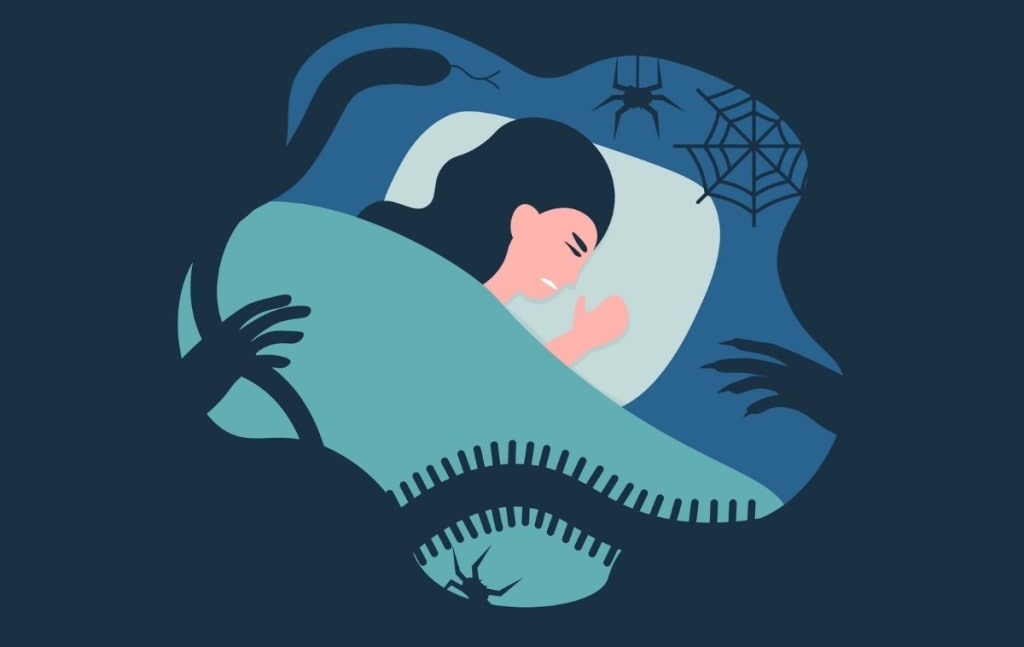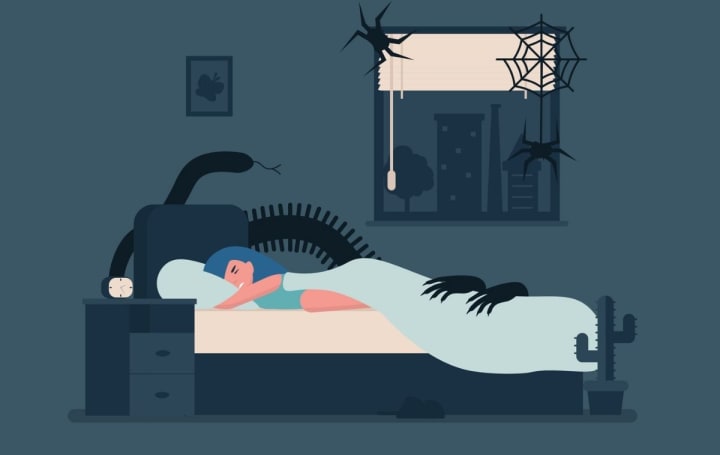Freaky Sleep Disorders That Are Surprisingly Common
The Creepy World of Hypnagogic Hallucinations, Sleep Paralysis, and Exploding Head Syndrome

Several years ago, I woke up to a tall, shadowy figure standing on the bed next to my head, looking down at me.
For an instant, I couldn’t move or scream, as though I were glued to the bed.
I blinked and suddenly I was free. I leaped out of bed with a scream - startling the living daylights out of my slumbering spouse - and bolted out of the bedroom.
I sat huddled in the corner of the hallway with my knees under my chin and arms wrapped around my legs like a scared child, wondering for the briefest of moments if aliens had come to abduct me.
No, I wasn’t crazy or on drugs.
And it turns out, I wasn't being abducted by aliens, either.
I’d actually just experienced my first hypnagogic hallucination, a type of parasomnia. The first of many, as it would turn out.
What Exactly are Parasomnias?

Parasomnias are any kind of sleep disorder that involve involuntary movements or perceptions that take place while asleep or in the stages between sleep and wakefulness.
They include sleepwalking, sleep inertia, sleep-related eating disorders (SRED), and even sleep-texting. (In case you needed another reason not to sleep with your phone next to the bed!)
While all parasomnias are disruptive to sleep in one way or another, here are a few that are downright creepy - even moreso because they’re surprisingly common.
Hypnagogic Hallucinations
Hypnagogic hallucinations are the perceived sights and sensations that someone has when they are semi-conscious between wakefulness and sleep. They aren't actually happening, but feel very tangible in the moment.
Visual hallucinations can take the shape of people, creatures (like bats or spiders), or strange abtract shapes. The hallucinations can also involve your other senses and make you experince smells and sounds that aren’t there, or cause the sensation of moving, falling, or flying.
In many cases, these hallucinations are downright terrifying. After all, wouldn’t you be afraid if you woke up and saw someone or something that wasn’t supposed to be there?
In my own experience, the hallucinations have always been visual, usually in the form of dark figures, bizarre floating shapes, or shadowy, swirling clouds.
Sleep Paralysis
This frightening condition is exactly what you think it is; the feeling of not being able to move while in a semi-conscious state between wakefulness and sleep. What’s worse is that sleep paralysis is often paired with hypnagogic hallucinations.
So not only are you seeing crazy things, you can’t run away from them either!
It usually only lasts for a few seconds but that's plenty of time to get totally freaked out.
Exploding Head Syndrome
This isn’t quite as horrible as it sounds, but it's still pretty unsettling. Exploding Head Syndrome (or EHS) happens when you’re half asleep and just as you're drifting off, you hear a loud, sudden noise that is sometimes accompanied by a flash of light.
Some people describe the noise to be like a loud crash, ringing, or gunshot.
It’s usually not painful, but you can bet it’ll shock the sheets right off of you.
Why Do Parasomnias Happen?

While these parasomnias sound terrifying, they’re not nearly as rare as you might think. In fact, experts believe that 25-33% of the population suffer from a hypnagogic hallucination at least once in their lifetime. (So if you ever wake up to bats by your bedside, you can at least take heart that you probably don't have bats in your belfry!)
As many as 4 in 10 people experience sleep paralysis, and up to 10% experience EHS.
Despite how common these sleep disorders are, why they happen is not largely understood, though we do have some ideas.
There seems to be a connection to hypnagogic hallucinations and the way your brain shuts down for sleep. The front part of your brain falls asleep faster than the back, which is why you may feel conscious but still experience sensory illusions.
A similar kind of brain miscommunication happens during sleep paralysis. The feeling of paralyzation happens naturally when your brain sends the message to your body that you're in REMS (Rapid Eye Movement Sleep), the stage of slumber when your dreams are most vivid. It’s meant to protect you from rolling out of your bed or acting out your dreams.
During sleep paralysis, you've awoken from REMS, but your brain hasn't sent the memo to your body yet.
As for EHS, some experts think that it's the result of a glitch in the brain’s shutdown process that causes a sudden burst of neural activity.
It's not clear why some people are more prone to these "brain hiccups" than others, but there is a link between parasomnias and insomnia, poor sleeping habits, anxiety, and stress. Other factors may include alcohol consumption, drug use, epilepsy, and mood disorders.
In my own case, I have definitely noticed a link between the episodes and my stress and anxiety levels.
Living with Parasomnias

Most of the time, parasomnias aren’t frequent or severe enough to cause concern. I used to have a several episodes a month, but now they only happen very rarely, maybe two or three times a year.
Educating myself on what was happening was the biggest thing that helped. They still startle me, but I recover a lot faster from them now that I know what they are. (Sometimes I can even get through an episode without shouting and waking up the house.)
I have removed a lot of stress and anxiety from my life and that has helped immensely, as has a routine sleep schedule. I’ve also become very focused on living a healthy lifestyle with regular exercise, healthy foods, and limited amounts of alcohol.
I was forutnate that my parasomnias are easily managed, but some people’s are severe enough to require medical intervention. The good news is, they can usually be treated with medication and CBT (Cognitive Behaviour Therapy).
Conclusion
Our brains aren't perfect and as a result, these lovely sleep "hiccups" are just a part of life for many people. Fortunately, aside from being a bit freaky and annoying, parasomnias are generally harmless.
I'll take that over an alien abduction any day.
If you found this article interesting, please hit the like button and consider leaving a small tip. Also, feel free to check out my other stories!
About the Creator
Corrie Alexander
Corrie is an ISSA-certified PT, fitness blogger, fiction-lover, and cat-mom from Ontario, Canada. Visit her website, thefitcareerist.com or realmofreads.com for book reviews and bookish tips.






Comments
There are no comments for this story
Be the first to respond and start the conversation.